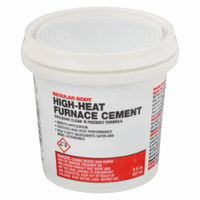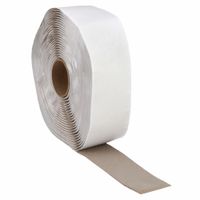Call +(254) 703 030 000 / 751 483 999 / 721 704 777
- Home
- Hvac And Refrigeration
- Hvac Installation Repair Mounting Equipment
- Hvac Tapes Sealants Cements
.....Read More
Frequently Asked Questions
What is the best HVAC tape for sealing ductwork?
The best HVAC tape for sealing ductwork is typically aluminum foil tape. Aluminum foil tape is highly recommended due to its durability, temperature resistance, and strong adhesive properties. It is specifically designed to withstand the extreme temperatures and pressures found in HVAC systems.
Key features of aluminum foil tape include:
1. **Temperature Resistance**: It can handle a wide range of temperatures, making it suitable for both hot and cold ducts.
2. **Moisture Resistance**: The foil surface is impervious to moisture, preventing mold and mildew growth.
3. **Adhesive Strength**: The strong adhesive ensures a long-lasting seal, preventing air leaks and improving system efficiency.
4. **Flexibility**: It conforms well to irregular surfaces and can be used on both rigid and flexible ductwork.
5. **UL Rating**: Many aluminum foil tapes are UL 181 rated, which is a standard for safety and performance in HVAC applications.
When selecting aluminum foil tape, look for products that are UL 181A-P or UL 181B-FX rated, as these are specifically tested for use with rigid and flexible ducts, respectively. Popular brands include 3M, Nashua, and Duck Brand, which offer reliable performance and durability.
In summary, aluminum foil tape is the best choice for sealing ductwork due to its excellent temperature and moisture resistance, strong adhesive properties, and compliance with industry standards.
How do I apply sealant to HVAC ducts?
1. **Preparation**: Turn off the HVAC system. Clean the duct surfaces with a damp cloth to remove dust and debris. Allow the ducts to dry completely.
2. **Inspection**: Examine the ducts for leaks, gaps, or loose connections. Pay special attention to joints, seams, and connections.
3. **Choosing Sealant**: Use mastic sealant or HVAC foil tape. Mastic is ideal for irregular surfaces, while foil tape works well on smooth surfaces.
4. **Application of Mastic Sealant**:
- Use a brush or gloved hand to apply mastic.
- Spread a thick layer (about 1/16 to 1/8 inch) over seams and joints.
- Ensure complete coverage, extending the sealant at least one inch beyond the seam.
- For large gaps, use fiberglass mesh tape over the gap before applying mastic.
5. **Application of Foil Tape**:
- Cut the tape to the required length.
- Peel off the backing and press the tape firmly over the seam or joint.
- Smooth out any wrinkles or bubbles to ensure a tight seal.
6. **Drying Time**: Allow mastic to dry for 24 to 48 hours. Foil tape does not require drying time.
7. **Final Check**: Once the sealant is dry, inspect the ducts to ensure all leaks are sealed. Turn on the HVAC system and check for any air leaks.
8. **Safety Precautions**: Wear gloves and a mask to protect against dust and fumes. Ensure proper ventilation in the work area.
9. **Maintenance**: Regularly inspect and maintain ductwork to ensure continued efficiency and performance.
Can refrigerant leak sealants damage my HVAC system?
Yes, refrigerant leak sealants can potentially damage your HVAC system. These sealants are designed to seal small leaks in the refrigerant lines by reacting with moisture and air to form a solid plug. However, their use can lead to several issues:
1. **Blockages**: Sealants can cause blockages in the system if they react with moisture or air inside the system, leading to clogs in the expansion valve, capillary tubes, or other narrow passages.
2. **Compressor Damage**: If the sealant reaches the compressor, it can cause damage by creating blockages or by reacting with the oil, leading to reduced lubrication and increased wear.
3. **Reduced Efficiency**: The presence of sealants can reduce the efficiency of the heat exchange process, leading to decreased system performance and increased energy consumption.
4. **Moisture Sensitivity**: Sealants are highly sensitive to moisture. If there is any moisture in the system, the sealant can react prematurely, causing internal blockages.
5. **Difficult Repairs**: Once a sealant is used, it can complicate future repairs. Technicians may find it difficult to identify and access the original leak, and the presence of sealant can interfere with standard repair procedures.
6. **Warranty Issues**: Using sealants may void the warranty of your HVAC system, as manufacturers often do not recommend their use due to potential risks.
7. **Environmental Concerns**: Improper use of sealants can lead to environmental harm if leaks are not properly addressed, allowing refrigerants to escape into the atmosphere.
While sealants can be a temporary fix for minor leaks, they are not a substitute for professional repair. It is advisable to consult with a qualified HVAC technician to assess and repair leaks properly.
What is the difference between HVAC tape and mastic sealant?
HVAC tape and mastic sealant are both used for sealing and insulating HVAC systems, but they differ in composition, application, and performance.
HVAC Tape:
1. Composition: Typically made from aluminum foil, fiberglass, or metalized film with an adhesive backing.
2. Application: Used for sealing ductwork seams, joints, and connections. It is applied by peeling off the backing and pressing the tape onto the surface.
3. Performance: Provides a quick and easy solution for sealing. It is effective for minor repairs and temporary fixes. However, it may not adhere well to dusty or oily surfaces and can degrade over time, especially in extreme temperatures.
4. Durability: Generally less durable than mastic sealant, as it can peel or lose adhesion.
5. Flexibility: Offers limited flexibility and may not conform well to irregular surfaces.
Mastic Sealant:
1. Composition: A thick, paste-like substance made from a blend of polymers and resins.
2. Application: Applied using a brush or trowel to seal ductwork seams, joints, and connections. It requires curing time to set properly.
3. Performance: Provides a long-lasting, airtight seal that is resistant to temperature fluctuations and environmental conditions. It adheres well to a variety of surfaces, including metal, fiberglass, and plastic.
4. Durability: Highly durable and less likely to degrade over time. It maintains its seal even under stress or movement.
5. Flexibility: Offers excellent flexibility, allowing it to conform to irregular surfaces and expand or contract with temperature changes.
In summary, HVAC tape is suitable for quick fixes and minor repairs, while mastic sealant is preferred for long-term, durable sealing solutions in HVAC systems.
How long does furnace cement take to cure?
Furnace cement typically takes about 24 hours to cure fully. However, the exact curing time can vary based on several factors, including the specific product used, the thickness of the application, and environmental conditions such as temperature and humidity. Some manufacturers may recommend a longer curing period, especially for thicker applications or in cooler, more humid environments.
For optimal results, it is crucial to follow the manufacturer's instructions regarding curing times and conditions. Generally, the cement should be allowed to air dry at room temperature. After the initial curing period, it is often recommended to gradually heat the cement to its operating temperature to ensure complete curing and to enhance its bonding properties. This process, known as "firing," helps to drive out any remaining moisture and solidify the cement's structure.
In some cases, a shorter curing time may be sufficient for light-duty applications or when using fast-setting formulations. However, for high-temperature applications, such as those involving furnaces, stoves, or fireplaces, allowing the full recommended curing time is essential to ensure the cement's durability and effectiveness.
Always consult the product's technical data sheet or contact the manufacturer for specific guidance on curing times and procedures for your particular application.
Are there any safety concerns when using HVAC sealants?
Yes, there are several safety concerns when using HVAC sealants:
1. **Toxicity**: Many HVAC sealants contain chemicals that can be toxic if inhaled or ingested. Proper ventilation is crucial during application to prevent inhalation of fumes, which can cause respiratory issues or other health problems.
2. **Skin and Eye Irritation**: Direct contact with sealants can cause skin irritation or allergic reactions. Protective gear such as gloves and goggles should be worn to prevent contact with skin and eyes.
3. **Flammability**: Some sealants are flammable and should be kept away from open flames or high heat sources. It is important to check the product label for flammability warnings and handle accordingly.
4. **Compatibility**: Not all sealants are suitable for every type of HVAC system. Using the wrong type of sealant can lead to system damage or failure. It is essential to ensure compatibility with the specific materials and components of the HVAC system.
5. **System Blockage**: Improper application or overuse of sealants can lead to blockages within the HVAC system, reducing efficiency or causing damage. It is important to follow the manufacturer's instructions carefully.
6. **Environmental Impact**: Some sealants may contain volatile organic compounds (VOCs) that contribute to air pollution. Choosing low-VOC or environmentally friendly products can mitigate this concern.
7. **Professional Application**: In some cases, the application of HVAC sealants may require professional expertise to ensure safety and effectiveness. Incorrect application can lead to system inefficiencies or safety hazards.
To mitigate these concerns, always read and follow the manufacturer's instructions, use appropriate personal protective equipment, and consider consulting a professional for application.
How do I choose the right insulation for HVAC pipes?
To choose the right insulation for HVAC pipes, consider the following factors:
1. **Material Type**: Common insulation materials include fiberglass, foam rubber, and polyethylene. Fiberglass is effective for high-temperature applications, foam rubber is flexible and resistant to moisture, and polyethylene is easy to install and cost-effective.
2. **Thermal Conductivity**: Select insulation with low thermal conductivity to minimize heat loss or gain. This ensures energy efficiency and maintains the desired temperature within the pipes.
3. **Moisture Resistance**: Choose materials with good moisture resistance to prevent condensation and mold growth, especially in humid environments. Closed-cell foam materials are typically more moisture-resistant.
4. **Fire Safety**: Ensure the insulation material meets fire safety standards. Materials should be non-combustible or have a high fire resistance rating to prevent fire hazards.
5. **Thickness**: The thickness of the insulation affects its thermal performance. Thicker insulation provides better thermal resistance but may be more expensive and harder to install in tight spaces.
6. **Durability**: Consider the durability of the insulation material, especially in areas exposed to physical damage or harsh environmental conditions. Durable materials reduce maintenance and replacement costs.
7. **Installation Ease**: Some materials are easier to install than others. Consider the complexity of the installation process and whether professional installation is required.
8. **Cost**: Balance the initial cost of the insulation with its long-term energy savings and maintenance costs. Higher upfront costs may be justified by better performance and durability.
9. **Environmental Impact**: Consider eco-friendly materials that have a lower environmental impact, such as those made from recycled materials or with low VOC emissions.
10. **Regulatory Compliance**: Ensure the chosen insulation complies with local building codes and regulations.
By evaluating these factors, you can select the most suitable insulation for your HVAC pipes, optimizing performance and efficiency.


